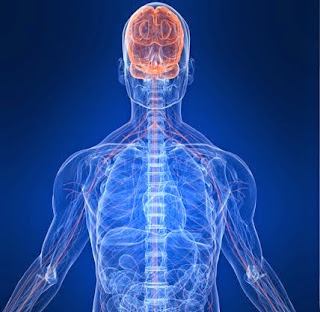Delving deeper into the fibre of the fabric
In some of the last few articles we've looked at various programs, exercises,
techniques and set and rep schemes.
In this episode we are going dive a little deeper inside the muscles and look at more than the mechanisms of a contraction, were going to take a look at how think and even feel about the contraction can help or hinder your process.
"put your brain in your Butt" (other good muscles are also available)! a phrase i use fairly often!
but why would putting your brain in your butt be of any use?
how can understanding and feeling the contraction benefit you and your training and what techniques and tricks can we use to enhance the process.
lets take a look at,
Making the Mind-Muscle connection.
Why i do i make such a point of you connecting with the muscles rather than just completing a move?
lets think, when you train, where is your mind?
Are you in the zone or are you texting in between sets or thinking about work or whats for dinner?
how in the zone are you when you lift? are you even aware of it?
Making the inner mind muscle connection is not for every exercise, don't get me wrong every exercise requires concentration,
but some require a different type of focus, some need large scale focus or "macro focus" of the whole process whilst some require or allow a detailed analysis with a more internal focus, where you can get lost inside the move and the muscle, a process i call "micro focus".
What do i mean?
Macro - large-scale; overall.
"the analysis of social events at the macro level"
lets take the Deadlift as an example of macro focus in action -
.jpg) |
| Focus |
the Deadlift is a fundamental lift for total body strength, this lift moves through many angles about many joints and requires nearly every muscle to work in unison to complete a well executed lift,
you need to focus on your posture, the positioning of your body relative to itself and the surrounding environment, drive, aggressiveness when needed and breathing all with a massive load trying to return to the earth.
your aim should be to lift that load as safe, efficient and effectively as possible.
Your focus is encompassed like an umbrella over the whole process, over all facets of the lift - "macro focus".
Micro - Extremely small.
"a micro buffet area"
Now lets look at a biceps curl for an example of micro focus -
 |
| Focus |
this lift moves about 1 joint, primarily the elbow and a little from the shoulder depending on the specific variation (you could argue the wrist too, but don't go splitting hairs),
when performing say the preacher curl your goal is total activation of the elbow Flexors,
due to the simplistic nature of the lift you do not require a great amount of skill to complete the move so external focus like balance and coordination and recruitment of large amounts of muscles are not required.
With that large portion of neural activity now free, it can be directed into the pure recruitment of the specific working muscles since its only small group needed for the lift,
due to the simplistic nature of the lift you do not require a great amount of skill to complete the move so external focus like balance and coordination and recruitment of large amounts of muscles are not required.
your focus can go deeper into the lift actively trying to flex the biceps rather than just liftng a bar up and down, you can concentrate and visualise the contraction taking place, you can directly make a connection between the move and the muscle working. from the outside they look similar but trust me these are two very different things,
One is merely going through the motions and the other is connecting with the lift.
That is training. Training that boarders on meditation, the person who gets closer or at least strives to get to that place whilst training see's infinitely more progress than the person who sees it as a means to an end.
Just as with everything, its more about how you get to your end goal than merely getting to the goal.
This applies at a macro but also a micro level too, not just in weeks and years but in milliseconds to seconds, from set to rep and to smaller and smaller focus.
"You can't only do rep 12, the twelfth rep is made by the previous 11 reps. so every rep literally counts and you must feel every one"
Developing the mind muscle connection or focusing on the working muscles "has been shown to improve your workout by at least 25%" (Schoenfeld)
The mind-to-muscle connection is scientifically referred to in a number of ways like neuromuscular communication, neuromuscular control, neuromuscular concentration, or neuromuscular innervation.
what ever you want to call it, the concept involves increasing the focus on the working muscle by actively concentrating on the singular contractions of the targeted muscle.
but what is it you are actually concentrating on?
what happens when you Flex!
When you consciously flex your biceps it starts with the brain, That urge to flex occurs as an electrical impulse that takes a rapid trip to your biceps, of speeds up to and around 120m/s!
All so you can stretch your shirtsleeves as you drink your protein shake.
the power of the flex is a result of output signal from our brain commonly referred to as neural drive another term (yes another) for the mind muscle connection. A strong connection gives you the ability to enhance the signal being sent and received for a stronger contraction, much like upgrading from a standard Internet cable to super fast fibre-optic broadband .
That signal travels down the spinal cord to the motor neuron that heads to the biceps where the electrical impulse sent by the brain reaches the space between the neuron and the muscles where that impulse triggers a release of chemicals known as neurotransmitters that attach to specific receptors in the muscle where a transfer of more chemicals triggers filaments within the muscle cells to attach and cause your muscles to contract (again we can delve even deeper here but ill save you the science).
its about more than the move
as Arnold said.
"The weights are just a means to an end; how well you contract the muscles is what training is all about."
and he wasn't wrong, the 7 time mr olympia and greatest bodybuilder in history swore by the mind muscle connection, the guy was way ahead of his time.
But what are the benefits of creating a strong mind-muscle connection and how can it increase our results?
- Recruit more muscle fibres - this alone creates secondary benefits, recruiting more muscle fibres increases the contractile force of the whole muscle, increasing the load you can lift and tension placed upon the muscle thus increasing intensity and total work performed.
- Increased intensity and staying in the zone.
- Increase the pump - secondary benefits. an increased muscle pump doesn't just feel good (i wont quote Arnie here) .the pump you experience plays a role my increasing metabolites within the muscle cells. This increase in intra and extra cellular fluid increases the stress to the muscle cells which triggers recovery.
- Increased movement quality. the increased tension and recruitment of motor units enhances muscular control.
how to enhance the mind muscle connection.
heres a just a few to get you started, i will expand on these in another article;
 1. lighten up - leave the ego at the door and lighten the load slightly, by not having to focus on raw power you can really feel the squeeze of the muscles. This doesn't have to compromise the effectiveness of the lift, infact if you can make the connection and recruit more muscle or work to a higher intensity it will actually benefit you more.
1. lighten up - leave the ego at the door and lighten the load slightly, by not having to focus on raw power you can really feel the squeeze of the muscles. This doesn't have to compromise the effectiveness of the lift, infact if you can make the connection and recruit more muscle or work to a higher intensity it will actually benefit you more. 2. slow down -
2. slow down -slow down each phase of the lift by applying a tempo method - by slowing the concentric and eccentric phases of the lift gives you more time to litterally focus on the muscle worked, especially as you contract - focus on gripping and squeezing hard.
3. Focus -
 litterally stare at the area you are trying to hit - obviously only works for certain muscles like biceps and the quads (dont let me catch staring at your own butt in the gym!). if your left bicep seems to be weaker than the right, next time on the preacher, stare at your left and focus on crushing the dumbell.
litterally stare at the area you are trying to hit - obviously only works for certain muscles like biceps and the quads (dont let me catch staring at your own butt in the gym!). if your left bicep seems to be weaker than the right, next time on the preacher, stare at your left and focus on crushing the dumbell.
4. Sensory feedback -
 |
| maybe a tad too far.... |
a tactic more often used by us as coaches to enhance a working set, especially when training muscles that you can't directly see such as the lats, as a coach can supply feedback via physically applying pressure to your lats to help you make the connection between the working muscles while performing the given lift to increase the contraction.
But there are a few ways that you can use that principle yourself - try this; next time you are on the leg extension dig your thumbs into your VMO (tear drop muscle above your knee) prior to your set, this will help you make the connection.
6. State and visualisation -
visualize the fibres within the muscle belly contracting and squeezing together, use music pre and during workout to place you in the right state to visualize, focus on your overall goal look over previous workouts and see the numbers to beat, focus on the goal of the workout and of each lift and see yourself stronger. This is a very powerful tool, and is no exception when it comes to weight training. being in the right state allows the ability to get in the required zone for intense work to take place. this one requires an article by itself which i am working on.
i will expand on these principles in a part 2 and 3 where i will give you some tactics and protocols you can implement in your training over the coming weeks.
till then
SHHHTick ARRound
EXCLUSIVE ACCESS! - stick your email Here to be on the ROTR inner circle, ill drop you knowledge bombs, free workouts, nutrition plans and more, feel free to drop some questions, ill help where i can!







